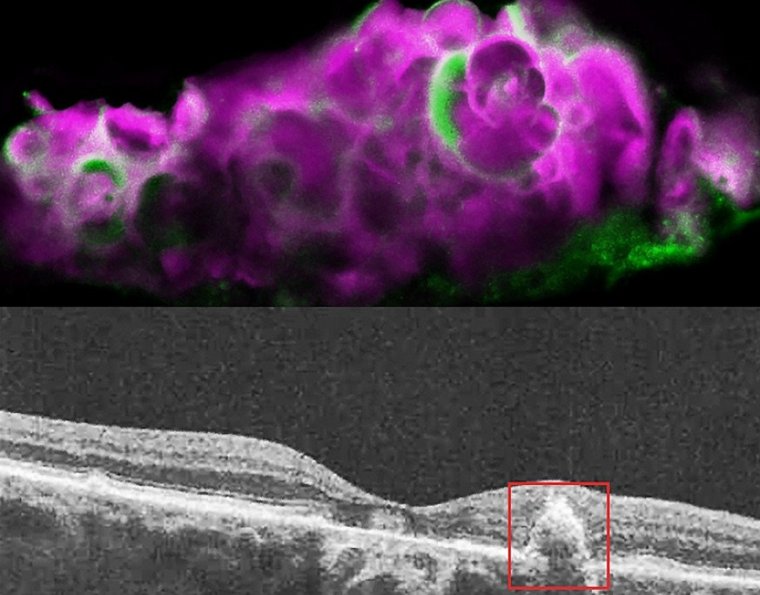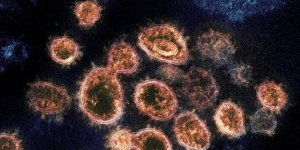| News / Science News |
Researchers discover tooth-enamel protein in eyes with dry AMD
A protein that normally deposits mineralized calcium in tooth enamel may also be responsible for calcium deposits in the back of the eye in people with dry age-related macular degeneration (AMD), according to a study from researchers at the National Eye Institute (NEI). This protein, amelotin, may turn out to be a therapeutic target for the blinding disease.

Top: HAP spherules (pink) and amelotin protein (green) in soft drusen from eye with dry AMD. Bottom: OCT image of eye with dry AMD, showing soft drusen beneath the retinal pigment epithelium. Photo: Dinusha Rajapakse/NEI
There are two forms of AMD – wet and dry. While there are treatments that can slow the progression of wet AMD, there are currently no treatments for dry AMD, also called geographic atrophy. I
n dry AMD, deposits of cholesterol, lipids, proteins, and minerals accumulate at the back of the eye. Some of these deposits are called soft drusen and have a specific composition, different from deposits found in wet AMD.
Drusen form under the retinal pigment epithelium (RPE), a layer of cells that transports nutrients from the blood vessels below to support the light-sensing photoreceptors of the retina above them. As the drusen develop, the RPE and eventually the photoreceptors die, leading to blindness.
The photoreceptors cannot grow back, so the blindness is permanent.
Recently, researchers found a calcium-containing mineral compound called hydroxyapatite (HAP) in dry AMD deposits. HAP is a key component of tooth enamel and bone.
Small balls of HAP filled with cholesterol, called spherules, were found only in drusen from people with dry AMD, and not in those with wet AMD or without AMD.
In this study, researchers discovered that if they starved RPE cells grown in transwells, a type of cell culture system, for nine days, the cells began to deposit HAP.
They determined that the protein amelotin, encoded by the gene AMTN, is strongly upregulated after extended starvation and is responsible for the mineralization of HAP in their cell culture model.
Blocking this pathway in their RPE cell line also blocked the production of these drusen-like deposits.
Prior to this study, nobody really knew how the hydroxyapatite was accumulating in the dry AMD drusen.
Why RPE cells in dry AMD begin depositing these HAP spherules is unclear, but it may be a protective mechanism gone awry. It’s possible that these protein, lipid and mineral deposits may help damaged RPE cells block blood vessels from growing into the retina, a problem that is one of the key features of wet AMD.
But when the mineral deposits get too extensive, they may also block nutrient flow to the RPE and photoreceptors, leading to retinal cell death. (National Institutes of Health)
YOU MAY ALSO LIKE





